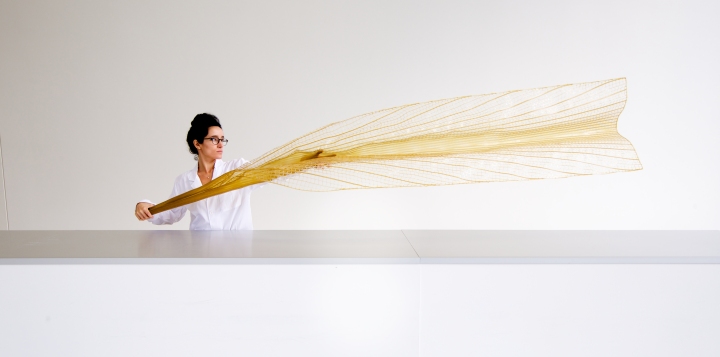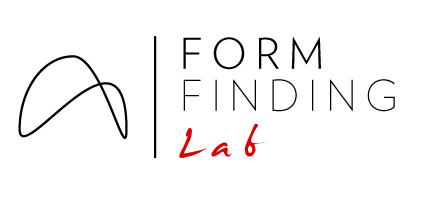Neri Oxman is an architect, designer, inventor and was a professor at the MIT Media Lab, where she was the founding director of The Mediated Matter Group, an experimental design practice combining commissioned works with the creation of enabling technologies and scientific knowledge. The Group conducts research at the intersection of computational design, digital fabrication, materials science, and synthetic biology; and applies that knowledge to design across disciplines and scales—from the micro scale to the building scale. Oxman pioneered the field of Material Ecology, which studies relationships and outlines interactions between designed objects and structures—fabricated with property gradients at the resolution of Nature, enabling multi-functionality that matches Nature—and their environs. Unlike the Industrial Revolution, which was ecology-agnostic, this new approach tightly links objects of design to the natural environment. Oxman’s work, documented in over 100 scientific publications, has been presented at the White House and the World Economic Forum, and is in the permanent collections of MoMA, SFMOMA, Pompidou, MFA, Cooper Hewitt, Smithsonian Design Museum, the FRAC, and the Museum of Science, amongst others. Projects include the Silk Pavilion (a robotically spun, biologically augmented structure); the Synthetic Apiary (a ‘perpetual spring’ environment for bees); a glass 3D printer; and 3D printed fluidic clothing for synthetic microorganisms. Neri Oxman won the National Design Award in 2018.
Heidi Legg: What is something you are currently working on that excites you?
Neri Oxman: In our latest project, Vespers, we revisited the typology of the death mask. We were intrigued by the idea of exploring an ancient and long-forgotten ‘product,’ and giving it new meaning through the lens of design, science and technology. Especially exciting for us was the challenge of transforming the customary single material mask, once molded to the face of the deceased and used as a memento, into a monolithic, multi-material, multi-functional mask that can be 3D printed and used as a biological urn.

HL: Who inspires you and your work?
NO: Those whom I admire inspire me: Picasso, Beethoven, [Ingmar] Bergman, Bernstein, Mies of course. With the exception of Mies, I’ve read all their biographies. The Magic Lantern is my favorite.
HL: Describe the collaborations in your work. In what ways do you blend the technical and creative aspects of your work?
NO: Our projects necessitate that we invent the technologies to create them. In that sense, the relationship between our design ambitions and the technologies that enable them is, well, ‘non-platonic’. There is a rather intimate transfer of content across product and process, artifact and technology, technique and expression.
A printed glass pavilion, for example, cannot be designed nor can it be built without a glass printer; our biomaterial structures could not have been designed or constructed without designing a robotic platform to design and build it; the Silk Pavilion would have not been constructed without a robotically woven scaffold on which to spin silk; the Wanderers would have not come to life without high resolution material modeling of macro-fluidic channels and the ability to print them. And so on.

Much of what we do can only be done at the MIT Media Lab. Where else on the planet can you genetically engineer microorganisms hosted in printed microfluidic devices, or print a squid sucker ring teeth protein and use it as a new thermoplastic material for biocompatible product design? Look, traditional biking is a self-limiting technology in the same way that leading a creative practice is; and thinking of a design practice through this lens is liberating, because, once you can identify its limits, you can redefine and therefore redesign it to outgrow itself. I think my lab has reached this limit and we’re now considering how to scale it up, in both size and breadth of applications.
In the end, our team operates as a ‘predictive practice’, a laboratory in which the future of design is being actively and empirically created, not merely questioned. We don’t regard ourselves as problem solvers, but as solution finders to problems that may not yet exist. I’d hate to give up that edge. Ever.
HL: What excites you about the future in your field?
NO: Textiles will in the future be designed as extensions of our bodies; they will be made of engineered living matter and will embody functionality unlike anything that exists today. Notions of textiles as skins have been around for many years but the way of getting there is only now emerging. 3D printed wearable living matter will become a reality in the years ahead as we discover how to control material properties using 3D printers on cellular length scales.
To deliver flexibility and comfort (breathability) we will need to control the microstructure and composition of the clothing matter itself. Rethinking what clothing is and what functions it can deliver is very much an opportunity that will emerge in the years ahead.
Designs that combine top down form generation with the bottom up growth of biological systems will open up real opportunities for designers working with digital fabrication and synthetic biology. Their main benefit is that they can enable the creation of systems that are truly dynamic—products and building parts that can grow, heal, and adapt. In the end, cells are simply small self-replicating machines. If we can engineer them to perform useful tasks, simply by adding sugar and growth media, we can dream up new design possibilities such as the ones described above.

HL: Describe the impact of your work: when your work leaves your workspace, who and where in the world does it reach?
NO: At the core of the mission [of the Mediated Matter Group] was the thesis that the world of design has been dominated since the industrial revolution by the rigors of manufacturing and mass production; that assembly lines have dictated a world made of parts, framing the imagination of designers and builders; and that the assumption that the parts themselves are made from single materials with homogeneous properties subsequently formed into predefined shapes, and fulfilling predetermined specific functions is a part of the design belief system and usually goes unquestioned; it is also enforced by how industrial supply chains work. Mediated Matter declared the close of the digital age; where design remained constrained by the canon of the machine age—the age of assembly. But it championed and advanced novel technologies that emerged from the digital age that are today enabling engineering and production at nature’s scales, ushering in what we like to think of as the fourth industrial revolution: the biological age of and for design.

I began with a few fearless team members, and our group slowly grew in size and in research areas… We’re excited to grow and explore what it means to scale up and out: to design in larger scales and to move beyond the walls of museums, galleries and cultural institutions. To build.
HL: What advice would you give to your past self or to today’s students?
NO: To younger generations of designers and architects, I profess that design is neither a profession nor a discipline; it is an acquired taste in synthesis. A good designer can, by virtue of design—the noun and the verb—not only solve problems but also seek them out, long before they emerge. Design, like language itself, conveys meaning through the creation of wholes that are bigger than the sum of their parts. And when a tight connection exists between method and form, technique and expression, process and product, one can enter the realm of the generative, where design transcends problem solving and becomes a system of thinking about making to attack any world problem.
This interview originally appeared in the proceedings for IASS 2018 at which the interviewee was a keynote speaker. These interviews make their first appearance online in this co-published series between this blog and the Digital Structures blog with the aim of inspiring a broader audience with the thoughts and insights of these outstanding individuals. Stay tuned on both blogs for more!
Interview material adapted from Oxman’s interview with Heidi Legg, Editor of TheEditorial.com, in March 2017.


One thought on “What I am thinking: architect, designer, inventor and alumn MIT professor Neri Oxman”